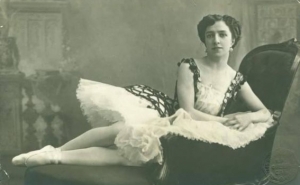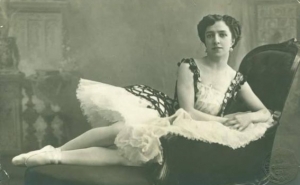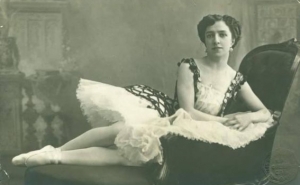"Michelangelo in the Ballet": Armenian Agrippina Vaganova, the Founder of the Theory of Russian Ballet

Agrippina Vaganova is a ballet dancer and teacher, the founder of the theory of Russian classical ballet, who brought up several generations of outstanding Russian ballerinas, including Marina Semenova and Galina Ulanova. Vaganova became famous, despite everything: her boby was considered inelegant, she was laughed at and humiliated. However this woman believed she was born for a ballet, 7days.ru writes.
Vaganova realized what the human body is capable of, how it can achieve grace and accuracy of movements. Her students would later say: "She knew everything about the body". And as Grand Ballerina Maya Plisetskaya once remarked in an interview, "Vaganova had fantastic brain. She saw immediately what was wrong. She was Michelangelo in the ballet."
Agrippina Yakovlevna Vaganova was born on June 14 (26), 1879, in St. Petersburg to an Armenian family. The family had three daughters, she was the youngest. Her father Akop (Yakov) Timofeyevich Vaganov served as an officer in Astrakhan, where an Armenian community had been formed since Tsar Ivan Grozniy. Yakov Timofeevich came from Persian Armenians. After the retirement, he moved to St. Petersburg. The Vaganov family lived poorly, in bad conditions. When Agrippina turned 10, she entered the St. Petersburg Theater School in the class of ballet. Successful students took a full board at the school, which could ease the burden of her family.
After graduating from college, Agrippina Vaganova was accepted into the ballet troupe of the Mariinsky Theater. A few years later she received the status of soloist. Vaganova brilliantly succeeded individual solo variations. For this the critics called her "the queen of variations."
Sometimes the criticism towards Vaganova was not very flattering. For example, Marius Petipa, the French and Russian ballet dancer, choreographer and teacher, wrote in his diary: "Mrs. Vaganova is terrible, I do not go to the ballet ..."
Vaganova indeed did not have the ballerina's body: small height, heavy, strong legs and hands. She knew about her shortcomings better than anyone else, and tried hard to achieve what the nature refused to give her. As Krassovskaya wrote about her, "a lively, sarcastic mind helped her to understand and overcome her own shortcomings and even turn them into dignities." Agrippina Yakovlevna bitterly recalled her life on the stage. The main parts in the ballets "Stream" by L. Delibes (Nail), "Swan Lake" by Tchaikovsky (Odette-Odile), "Humpbacked Horse" (Tsar-maiden), "Giselle" by A. Adana (Giselle) were trusted to her only shortly before the end of her performing career. In 1915, Agrippina received the title of ballerina, and in 1916 she left the stage.
Then her pedagogical activity began. Vaganova held her first lesson, then the second, the third, and suddenly she understood everything. She was born to be a ballet teacher, not a performer: that was the secret! What a pleasure it was to teach, after all! The name of Agrippina Vaganova is surrounded by legends, her severity and sincerity, rare praise seemed eccentric. Her fame as a teacher flashed like fireworks and continues to shine up until now, Peoples.ru writes.
Agrippina Vaganova developed her own pedagogical system. "The Vaganova System" played a decisive role in the development of the ballet art of the 20th century. In 1934 Agrippina Vaganova's book "The Basics of Classical Dance" was published. The book survived six reissues and was translated into many languages of the world. Vaganova herself was not an outstanding ballerina: her real talent was to teach others the art of dance, to make available to her students what she realized herself. Boris Eifman said: "The Russian ballet is the Vaganova ballet! Everything was invented by Agrippina Vaganova! She introduced everything that today is identified with the Russian ballet," Shkolazhizni.ru writes.
On November 5, 1951 Vaganova passed away. During the farewell, the adagio from "Swan Lake" sounded. In the documentary film "Agrippina Vaganova: Great and Dreadful," Maya Plisetskaya recalls her: "There was no second Vaganova, and I do not know whether there will ever be ..."
-
 17:08
17:08The regular session of the Anti-corruption Policy Council takes place in Jermuk
-
 15:05
15:05The Prime Minister sends congratulatory messages to the supreme leader of Iran and the President of Iran
-
 11:11
11:11Armenia sends earthquake aid to Turkey
-
 10:43
10:43Commemoration of the Pontiff St. Sahak Partev
-
 09:16
09:16Some roads are closed and difficult to pass in Armenia
-
 19:55
19:55Phone conversation of the Foreign Minister of Armenia with the U.S. Assistant Secretary of State for European and Eurasian Affairs
-
 18:30
18:30Prime Minister Pashinyan and President Khachaturyan meet
-
 18:20
18:20Ararat Mirzoyan with Co-Chairman of the OSCE Minsk Group of France Brice Roquefeuil
-
 17:01
17:01Humans could land on Mars within 10 years, Musk predicts
-
 16:45
16:45France, US urge 'immediate' end to Nagorno Karabakh blockade
-
 16:01
16:01Blockaded Nagorno Karabakh launches fundraiser to support quake-hit Syria
-
 15:59
15:59Earthquake death toll in Turkey rises to 18,342
-
 15:43
15:43Ararat Mirzoyan Held a Telephone Conversation with Sergey Lavrov
-
 15:06
15:06French president rules out fighter jet supplies to Ukraine in near future
-
 14:47
14:475 Day Weather Forecast in Armenia
-
 14:44
14:44President Vahagn Khachaturyan wrote a note in the book of condolences opened in the Embassy of Syria in Armenia
-
 14:20
14:20Azerbaijan’s provocations impede establishment of peace and stability – Armenian FM tells Russian Co-Chair of OSCE MG
-
 12:57
12:57France representation to OSCE: Paris calls on Azerbaijan to restore freedom of movement through Lachin corridor
-
 11:40
11:40Command of Kosovo forces highly appreciated preparation of Armenian peacekeepers
-
 10:16
10:16The United States withdrew from sanctions against Syria for six months the provision of assistance after the earthquake
day
week
month
Humidity: %
Wind: km/h




